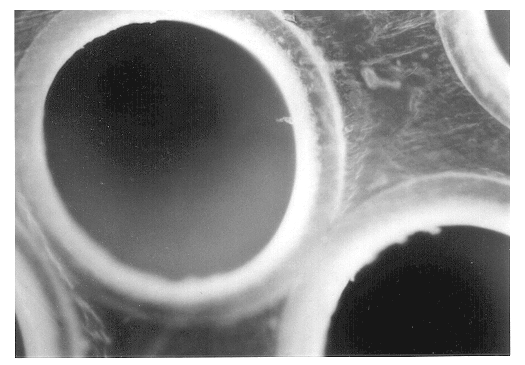Filter element
- Summary
- Abstract
- Description
- Claims
- Application Information
AI Technical Summary
Problems solved by technology
Method used
Image
Examples
example 2
A module of filter element was formed by bundling 780 hollow fiber type separation membranes made of polysulfone, 0.1 .mu.m in maximum pore diameter, 450 .mu.m in outside diameter and 300 .mu.m in inside diameter, inserting the bundle in an outer tube made of high-density polyethylene, melting high-density polyethylene in advance at 140.degree. C. in a depressed metallic die, inserting the open terminal parts of the bundled hollow fiber type separation membranes in the melt of high-density polyethylene, and allowing the wetted open terminal parts to cool gradually. Then, this module was kept immersed in an aqueous alkaline detergent solution of pH 12 at 60.degree. C. for 15 days, washed with water, and tested for bubble point. It was consequently found to have a bubble point value of 3.8 kg / cm.sup.2, a normal level.
example 3
A module of filter element was formed by bundling 50 ultrafilter membranes made of polysulfone, 1200 .mu.m in outside diameter and 700 .mu.m in inside diameter, inserting the bundle into an outer tube made of polypropylene, preparing the raw material for a sealed part in the form of paste having a fine powder of polypropylene dispersed in ethyl alcohol, inserting the open terminal parts of the hollow fiber type separation membranes in the paste, heating only the open terminal parts in an oven at 180.degree. C. for 12 hours, and allowing the hot terminal parts to cool gradually in the oven. This module was kept immersed in an aqueous 5% dilute hydrochloric acid solution at room temperature for six weeks, washed with water, and tested for leakage by the standard method of applying pneumatic pressure to the module from the primary side while immersing the module in water. It was consequently found to have no leakage.
The filter elements which were formed by using a natural or synthetic ...
PUM
| Property | Measurement | Unit |
|---|---|---|
| Force | aaaaa | aaaaa |
| Length | aaaaa | aaaaa |
| Length | aaaaa | aaaaa |
Abstract
Description
Claims
Application Information
 Login to View More
Login to View More - R&D
- Intellectual Property
- Life Sciences
- Materials
- Tech Scout
- Unparalleled Data Quality
- Higher Quality Content
- 60% Fewer Hallucinations
Browse by: Latest US Patents, China's latest patents, Technical Efficacy Thesaurus, Application Domain, Technology Topic, Popular Technical Reports.
© 2025 PatSnap. All rights reserved.Legal|Privacy policy|Modern Slavery Act Transparency Statement|Sitemap|About US| Contact US: help@patsnap.com


